This post was published in Door Security + Safety
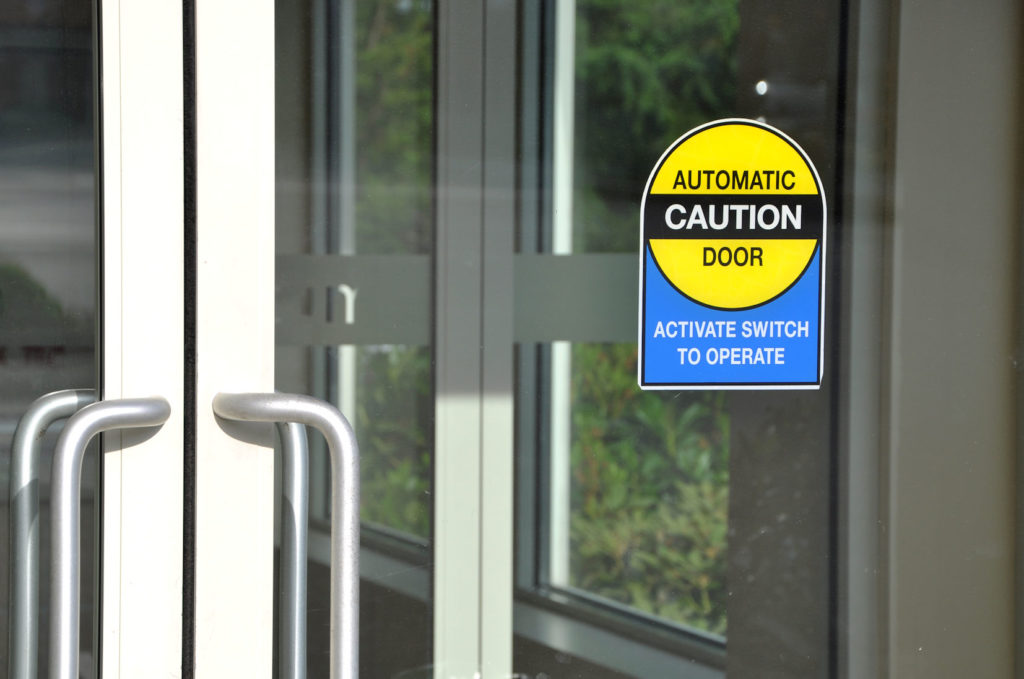 As automatic doors become more common in buildings of all occupancy types, it’s important to understand the applicable requirements of the codes and standards. The standards address design and operational mandates such as opening/closing force and speed, maneuvering clearance and standby power, and the methods used to actuate the automatic operation of the door. In addition, the standards include safety requirements related to sensors or mats, guide rails, and signage.
As automatic doors become more common in buildings of all occupancy types, it’s important to understand the applicable requirements of the codes and standards. The standards address design and operational mandates such as opening/closing force and speed, maneuvering clearance and standby power, and the methods used to actuate the automatic operation of the door. In addition, the standards include safety requirements related to sensors or mats, guide rails, and signage.
Signage for automatic doors must be maintained throughout the life of the building – even if the glass is replaced or a cleaning product causes the adhesive sign to peel. While the other requirements of the standards are incorporated into the design or installation of the automatic door assembly, signage is more likely to become non-compliant (or non-existent) over time.
The model codes don’t include prescriptive requirements for signage for automatic doors – these are found in the referenced standards. For power-operated swinging doors, power-operated sliding doors, and power-operated folding doors, the International Building Code (IBC) requires compliance with BHMA A156.10 – Standard for Power Operated Pedestrian Doors. Power-assisted swinging doors and low-energy power-operated swinging doors are required to comply with BHMA A156.19 – Standard for Power Assist and Low Energy Power Operated Doors. NFPA 101 – Life Safety Code also references these standards for automatic doors.
BHMA A156.19 – Standard for Power Assist and Low Energy Power Operated Doors
The requirements for signage on doors with low-energy operators are found in Section 6 of BHMA A156.19:
- Signage instructing the user on the operation and function of the door must be visible from both sides of the door.
- Signs must be mounted 50 inches +/- 12 inches from the floor to the center of the sign.
- Letters must be 5/8-inch high, minimum.
- For low-energy operators, the sign must read “AUTOMATIC CAUTION DOOR”.
- Signs must be 6 inches diameter, minimum, with black letters on a yellow background.
- Additional information may be included on the sign.
In addition to the signs above, automatic doors must have signage describing the operation of the door. These signs must have white letters on a blue background, mounted on both the push and pull sides of the opening:
- For low energy operators with a knowing-act switch, the sign must read, “ACTIVATE SWITCH TO OPERATE”. If a switch is only installed on one side of the door (push side or pull side), the sign must be located on the same side of the door as the switch.
- For low energy operators initiated by pushing or pulling the door, the signs must read “PUSH TO OPERATE” and “PULL TO OPERATE”.
- For power assist doors with a knowing act switch, the sign must read, “EASY OPEN DOOR – ACTIVATE SWITCH THEN OPEN DOOR”.
- For power assist doors operated by pushing or pulling the door or by a remote device, the signs must read “EASY OPEN DOOR – PUSH TO OPERATE,” and “EASY OPEN DOOR – PULL TO OPERATE”.
BHMA A156.10 – Standard for Power Operated Pedestrian Doors
Doors required to comply with BHMA A156.10 include power-operated pedestrian doors, as well as doors with low-energy operators that are not operated by a knowing act. The signage requirements of A156.10 apply to swinging, sliding, and folding doors, and the signage must be visible from both sides of the door. Currently, the standard requires signage stating “AUTOMATIC DOOR” with letters 1/2-inch high minimum, although the visual character requirements of ICC A117.1 – Accessible and Usable Buildings and Facilities, require a minimum character height of 5/8-inch.
Swinging Doors:
- In addition to the automatic-door sign, BHMA A156.10 requires swinging doors to have an arrow indicating the approach side of the door, mounted at 50 inches +/- 12 inches from the floor to the center of the sign. The sign must be a minimum of 6 inches in diameter, with a green circle surrounding a black arrow on a white background.
- On doors that swing toward pedestrians when they attempt to travel in the wrong direction, BHMA A156.10 requires an international “DO NOT ENTER” sign, also mounted at 50 inches +/- 12 inches above the floor and a minimum of 6 inches in diameter, with a red circle with the words “DO NOT ENTER” within the circle.
- When a swinging door serves both egress and ingress, signage of the same diameter and mounting height range must state “AUTOMATIC CAUTION DOOR” in black lettering on a yellow background.
Sliding Doors:
- Sliding doors with swinging leaves that “break out” (or “break away”) for emergency use must have signs reading “IN EMERGENCY PUSH TO OPEN”. The signs must have a red background with contrasting letters a minimum of 1 inch high, which are read horizontally. These signs must be located adjacent to the lock stile on the egress side of the door, between 36 inches and 60 inches above the floor.
- When a sliding door slides past an adjacent sidelight or wall, a sign must instruct building occupants to stand clear of the sliding door’s travel path. The letters must be 1 inch high, minimum, on a contrasting background, and the signs mounted between 36 inches and 60 inches above the floor.
Folding Doors:
- For folding doors that accommodate one-way traffic, doors must have an arrow sign that is visible from the approach side, mounted 50 inches +/- 12 inches above the floor, on the “fold-slide” panel (also known as the FX panel). The sign must be a minimum of 6 inches in diameter, with a green circle surrounding a black arrow on a white background.
- On the non-approach side of these doors, BHMA A156.10 requires an international “DO NOT ENTER” sign, also mounted at 50 inches +/- 12 inches above the floor and a minimum of 6 inches in diameter, with a red circle with the words “DO NOT ENTER” within the circle.
- For pairs of folding doors, both “fold-slide”/FX panels are required to have this signage.
- Folding doors that serve both ingress and egress must have arrow signs as described above, visible from the non-fold side, and the fold side must have the “AUTOMATIC CAUTION DOOR” signs described above.
- Folding doors with leaves that “break out” (or “break away”) for emergency use must have signs reading “IN EMERGENCY PUSH TO OPEN”. The signs must have a red background with contrasting letters a minimum of 1 inch high, reading horizontally. These signs must be mounted on the “fold-slide”/FX panel(s) on the egress side, with a “DO NOT ENTER” sign on the non-traffic side of the “fold-slide”/FX panel(s).
Proper signage is critical to the safe operation of automatic doors, so the signage required by the standards must be maintained throughout the life of the door assembly. For additional information and diagrams depicting the signage requirements, refer to the applicable BHMA standard, available from the Builders Hardware Manufacturers Association.
You need to login or register to bookmark/favorite this content.

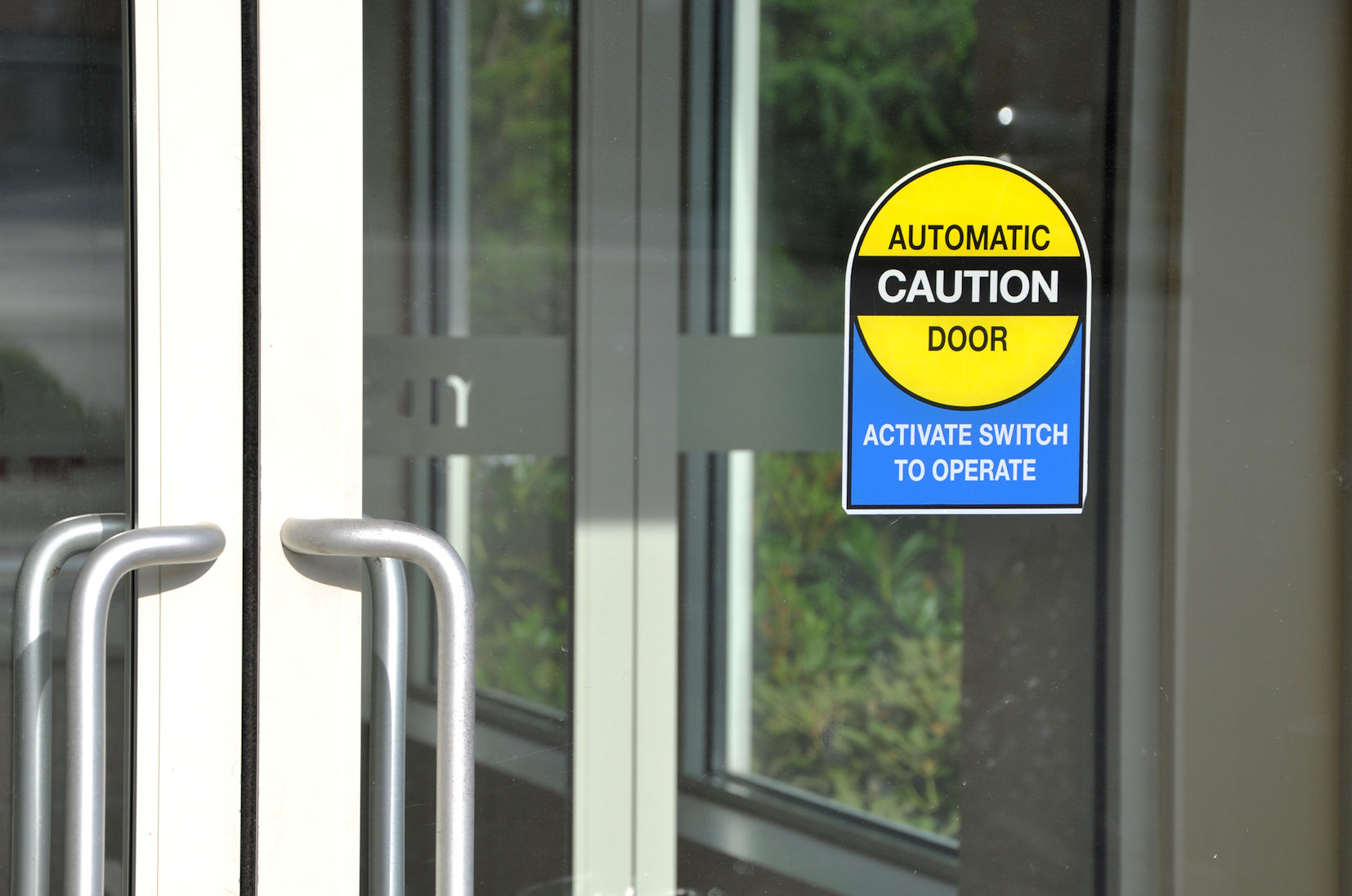

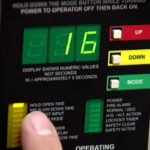

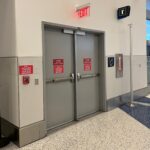

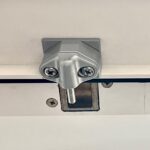

Great info thanks Lori
Its really nice website. Thanks for giving full information about Automatic Doors.
[…] Decoded: Signage for Automatic Doors – I Dig Hardware … […]
[…] Decoded: Signage for Automatic Doors – I Dig Hardware […]
I was happy that you mentioned in your post that signage instructing the user on the operation and function of the door must be visible from both sides of the door. We are planning to replace our old entrance door with an automatic one. I will ensure we have this door soon, with signage instructions on both sides.